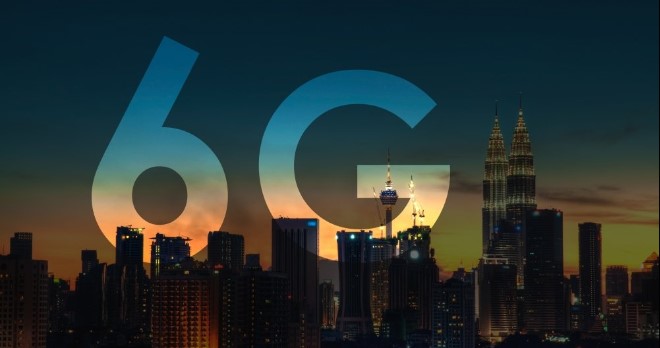Over the past 30 years, cellular communications have brought unprecedented benefits to humankind. 2G and 3G unleashed the potential of human mobility and connectivity.
RELATED: OPPO unveils new 6G white paper examining the future of world mobility
4G gave us greater access to information and social engagement. 5G has enabled us to leverage data from machines and sensors. In 6G, we will experience the fusion of physical and digital worlds which will transform the way we live and work.
Figure 1: Evolution of cellular communications towards 6G
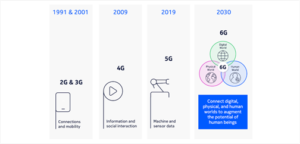

What will 6G networks be capable of that cannot be achieved with today’s 5G networks?
While today’s most advanced 5G networks deliver the highest performance technically feasible, developments in adjacent fields such as AI/ML, semiconductors and material science will allow future telecommunication networks to achieve even loftier goals.
Figure 2. Use case evolution from 5G to 6G
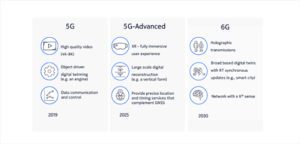

Following the footsteps of previous generations, 6G will not only enhance the fundamental features of 5G such as enhanced mobile broadband (eMBB), massive machine-type communications (mMTC), and ultra-reliable low-latency communications (URLLC), but it will also come with additional enhancements in reliability, positioning, sensing accuracy, and foremost energy efficiency.
Seamless interactions between the physical and the digital worlds will be key characteristics of 6G. Multi-sensory and immersive communications will enable the true realization of eXtended Reality (XR)1. Metaverse and digital twins will be further advanced by 6G, while Cobots2 will drive the needs for high-accuracy sensing, positioning, and reliability in complex industrial environments.
6G must address sustainability and tackle digital inequality. Its success will be measured not just by the telecom industry’s own contributions, but also by how it will enable other industries and governments to reach their sustainability targets.
Figure 3. Drivers of 6G
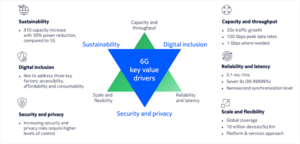

When will 6G arrive?
Typically, new cellular technologies are developed with a horizon of approximately 10 years. We expect 6G in its nascent stage towards the end of this decade and on a firmer footing early in the next decade. Research projects around the world, such as Hexa-X and Hexa-X-II3, which Nokia leads, are developing technical elements of this next generation of networks. Through the World Radiocommunication Conferences (WRC), ITU-R4 is expected to decide on the frequency bands and the conditions for 6G. Alongside ITU-R, 3GPP will need to conclude on the standardization requirements with the first 6G specifications expected to be available in 3GPP Release 21 in 2H28.
Decisions on candidate spectrum bands to be studied for 6G are likely to be taken at WRC-23, which will ensure that the usage conditions will be studied and become available by 2030.
Figure 4: Nokia’s expected timelines for 6G standardization
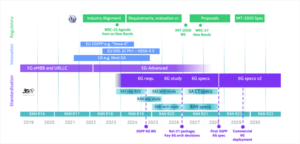

Do we need different spectrum for 6G?
The industry’s experience from the development and the roll out of previous mobile generations highlighted the vital importance for each mobile generation to have its own dedicated “launch” spectrum e.g., UMTS @2GHz, LTE @2.6GHz, 5G @3.5GHz. As we approach WRC-23, the questions that arise when discussing 6G candidate bands are: why more spectrum, why now, how much and from which frequency bands?
The successful kickstart of each mobile generation greatly benefits from the availability of new pioneer bands enabling macro-cellular deployments. The global cellular traffic is growing yearly, and it will continue to grow throughout the decade. Studies estimate that cellular traffic volume will triple between 2022 and 2027 (Figure 5). Therefore, additional spectrum will be required to support such growth in an economically and environmentally sustainable way.
Figure 5: Cellular data traffic growth estimates, 2020-2027
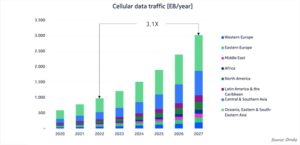

Why now?
Spectrum is the lifeblood of wireless broadband mobile communication and without timely access to the right spectrum, most of the promises of 6G will remain unfulfilled. A spectrum roadmap for 6G needs to be defined well in advance, since typically it takes up to a decade from a WRC decision to implement and deploy new mobile generation spectrum. Thus, for the right spectrum to be made available in the upcoming years, we need to act now.
From which bands?
Spectrum in different frequency ranges – low, medium, and high – is critical for the commercial success of 6G. One key learning from the introduction of 5G is that reusing the existing network site infrastructure with new spectrum is vital for network planning and cost efficiency.
Nokia considers that, to balance capacity and coverage, new mid-band spectrum from within the 7-15 GHz frequency range is needed, specifically from within 7.125-8.5 GHz, 10.7-13.25 GHz, and 14-15.35 GHz. Focus on these ranges in the next ITU-R study cycle would enable spectrum availability in time for the introduction of 6G before 2030.
Additional 6G research is ongoing on sub-THz spectrum that can be useful for applications like high accuracy sensing and positioning. As the propagation characteristics of sub-THz frequencies do not allow for efficient delivery of capacity and coverage in wide area networks, such spectrum can only complement the mid-bands, not replace them.
Figure 6 Nokia spectrum vision in the 6G era
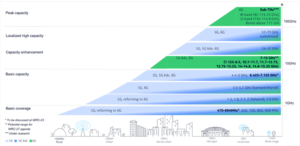

From a regulatory perspective, IMT5 identification of new spectrum in the extended mid-band will be vital for the industry, as it can enable global or regional harmonization, provide regulatory certainty for technological investments in the ecosystem, and create economies of scale for faster development and broader adoption.
How much?
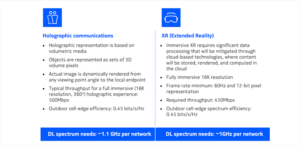

Initial 6G spectrum need calculations for XR and holographic communications have been developed by GSA6, with Nokia as an active contributor. To address the needs of some of the 6G data-hungry use-cases, the minimum wide-area spectrum required is estimated to be roughly 1 GHz per network.
Considering three to four operators per country and assuming that in the long-term the existing mid-band spectrum available for IMT (roughly ~1GHz) will solely be reused to address the wide-area use cases, then approximately 500-750 MHz of additional new wide-area spectrum per network will be needed in the 7-15 GHz range.
The decisions of previous WRCs that identified spectrum for IMT were proven to be prudent. The existing global spectrum map has been vital for the development of new technologies, vertical industries, enhanced ecosystems, societal benefits and economic growth, but the question remains: will this spectrum be adequate for 6G?
As we approach WRC-23, we feel that it is time to demystify the myths. The next four questions address these myths and bring more clarity on the need for new spectrum for 6G.
Why is more spectrum needed when there is already so much spectrum available for IMT?
While refarming existing frequency bands to deploy 6G is possible, it poses regulatory and compatibility challenges. The sunset of previous mobile generations is not a straightforward process, and we are still learning from the phase out of 2G and 3G. Even though current technology advancements allow the parallel use of different mobile generations in a single frequency band where needed, they can only be considered as temporary solutions, as they do not achieve efficient utilization of spectrum. Nevertheless, even if regulatory, compatibility and efficiency challenges were to be overcome, existing available spectrum will still not be enough to meet the expected data traffic demand for 6G by the end of the decade.
Why is more spectrum needed when deployment of mobile networks can be densified to achieve higher throughputs?
Network densification is not always an economically viable or sustainable solution. Small cells need to maintain distinct separation distances to avoid inter-cell interference, while deployment density needs to maintain the same levels of experience during cell handovers. Identifying locations for numerous small cells makes network planning and deployment significantly more challenging, while the acquisition and running cost to achieve extreme densification will significantly increase the deployment and operational cost.
Extreme densification to deliver high user experience will also adversely impact the carbon footprint. Recent studies7 have indicated that in the absence of additional mid-band spectrum, the total cost of network ownership will be 3-5 times higher over a ten-year period, and the carbon footprint will be 1.8-2.9 times greater to deliver the target performance levels. Therefore, densification on its own cannot be considered the sole solution to additional capacity.
Why is more mid-band spectrum needed when there is high potential for a broader IMT identification in the upper 6GHz band?
Different frequency ranges satisfy different spectrum needs and support different use-cases. Early reports8,9,10 suggest various amounts of spectrum needed to provide full 6G experience in a macro-cellular environment. The upper 6 GHz band (6425-7125 MHz) will be vital for enabling growth and will mostly be used in further 5G-Advanced evolution, and eventually, in some countries, as basis for 6G introduction. However, this band alone, with its total of 700 MHz available, will not be sufficient to satisfy the individual national spectrum demands for 6G. Moreover, its potential for being globally harmonized for mobile (IMT) use is unlikely.
Why is more spectrum needed when existing mmWave spectrum is currently under-utilized?
The mmWave spectrum is a promising range for high-capacity enhancements mainly in dense urban environments. Nevertheless, the nature of signals in these frequencies cannot offer a viable solution for macro cellular coverage. Available spectrum in the mmWave bands can achieve Gigabit speeds but only in small ranges. Considering the propagation challenges, as well as the economic and sustainability challenges posed by extreme densification, it is clear that mmWave spectrum is optimal for local capacity enhancements, not for macro-cellular coverage.
Conclusion
Over the past thirty years, cellular telecommunications have brought unprecedented benefits to humankind, and their impact is expected to be even greater over the next several decades with the adoption of 6G.
In addition to the currently designated spectrum, 6G will require new spectrum to meet the data demands by 2030. New spectrum will act as the enabler for the industry to meet its targets in the areas of efficiency, performance, and sustainability, while still maintaining a viable economic environment to attract investments. From a regulatory perspective, IMT identification of new spectrum in the extended mid-band 7-15 GHz (i.e., 7.125-8.5 GHz, 10.7-13.25 GHz, and 14-15.35 GHz) will be vital for the industry. It can enable global and regional harmonization, provide regulatory certainty for technological investments in the ecosystem, and enable the economies of scale needed for faster development and broader adoption.
Figure 7: Summary of Nokia’s view on spectrum for 6G
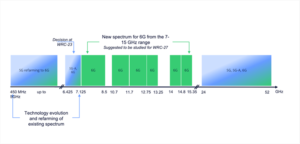

Being at the forefront of cellular technology development, Nokia leads the 6G race to meet the needs of society in the future. Spectrum is the steppingstone for this development and the full realization of the 6G experience. So far, spectrum for IMT has enabled the world to progress from text messaging and social media to live streaming and AR applications. With 6G we aim to go a step beyond, creating the foundations for the generation of a new physical11 reality.
Read the explainer – Spectrum for 6G explained to know more about 6G spectrum nokia.com.


